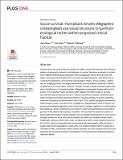Files in this item
Social survival : humpback whales (Megaptera novaeangliae) use social structure to partition ecological niches within proposed critical habitat
Item metadata
| dc.contributor.author | Wray, Janie | |
| dc.contributor.author | Keen, Eric | |
| dc.contributor.author | O’Mahony, Éadin N. | |
| dc.date.accessioned | 2021-07-07T15:30:09Z | |
| dc.date.available | 2021-07-07T15:30:09Z | |
| dc.date.issued | 2021-06-23 | |
| dc.identifier | 274800378 | |
| dc.identifier | 36011cbf-b20d-43c8-b7ae-f7b41eeb48d5 | |
| dc.identifier | 000671691900026 | |
| dc.identifier | 85108515517 | |
| dc.identifier.citation | Wray , J , Keen , E & O’Mahony , É N 2021 , ' Social survival : humpback whales ( Megaptera novaeangliae ) use social structure to partition ecological niches within proposed critical habitat ' , PLoS ONE , vol. 16 , no. 6 , e0245409 . https://doi.org/10.1371/journal.pone.0245409 | en |
| dc.identifier.issn | 1932-6203 | |
| dc.identifier.other | RIS: urn:826A425B70A96A75BA6A78C125451156 | |
| dc.identifier.other | ORCID: /0000-0002-0755-1329/work/128568192 | |
| dc.identifier.uri | https://hdl.handle.net/10023/23485 | |
| dc.description | Funding: JW received a grant from the following: Save Our Seas Foundation Grant No. 217-2010- 2020 https://saveourseas.com, Willow Grove Foundation Grant No. 001-2010-2020, Fisheries and Oceans Canada Grant CA No.: 2016-2019- HSP-PAC-8287-A, https://www.dfo-mpo.gc.ca/species-especes/sara-lep/hsp-pih/index-eng.html, Donner Canadian Foundation Grant No. E-50-20,E50-19, E-50-18 https://www.donnerfoundation.org, Tides Canada Grant No. GF04712. https://makeway.org. | en |
| dc.description.abstract | Animal culture and social bonds are relevant to wildlife conservation because they influence patterns of geography, behavior, and strategies of survival. Numerous examples of socially-driven habitat partitioning and ecological-niche specialization can be found among vertebrates, including toothed whales. But such social-ecological dynamics, described here as ‘social niche partitioning’, are not known among baleen whales, whose societies—particularly on foraging grounds—are largely perceived as unstructured and incidental to matters of habitat use and conservation. However, through 16 years of behavioral observations and photo-identifications of humpback whales (Megaptera novaeangliae) feeding within a fjord system in the Canadian Pacific (primarily within Gitga’at First Nation waters), we have documented long-term pair bonds (up to 12 years) as well as a complex societal structure, which corresponds closely to persistent patterns in feeding strategy, long-term site fidelity (extended occupancy and annual rate of return up to 75%), specific geographic preferences within the fjord system, and other forms of habitat use. Randomization tests of network congruency and clustering algorithms were used to test for overlap in patterns of social structure and habitat use, which confirmed the occurrence of social niche partitioning on the feeding grounds of this baleen whale species. In addition, we document the extensive practice of group bubble net feeding in Pacific Canada. This coordinated feeding behavior was found to strongly mediate the social structure and habitat use within this humpback whale society. Additionally, during our 2004–2019 study, we observed a shift in social network structure in 2010–2012, which corresponded with environmental and demographic shifts including a sudden decline in the population’s calving rate. Our findings indicate that the social lives of humpback whales, and perhaps baleen whales generally, are more complex than previously supposed and should be a primary consideration in the assessment of potential impacts to important habitat. | |
| dc.format.extent | 34 | |
| dc.format.extent | 1887133 | |
| dc.language.iso | eng | |
| dc.relation.ispartof | PLoS ONE | en |
| dc.subject | QL Zoology | en |
| dc.subject | GC Oceanography | en |
| dc.subject | DAS | en |
| dc.subject | NIS | en |
| dc.subject | MCC | en |
| dc.subject.lcc | QL | en |
| dc.subject.lcc | GC | en |
| dc.title | Social survival : humpback whales (Megaptera novaeangliae) use social structure to partition ecological niches within proposed critical habitat | en |
| dc.type | Journal article | en |
| dc.contributor.institution | University of St Andrews. School of Biology | en |
| dc.identifier.doi | 10.1371/journal.pone.0245409 | |
| dc.description.status | Peer reviewed | en |
This item appears in the following Collection(s)
Items in the St Andrews Research Repository are protected by copyright, with all rights reserved, unless otherwise indicated.

